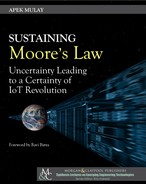90 12. AN ENGAGEMENT WITH SEMICONDUCTOR INDUSTRY
from megahertz to gigahertz, a thousand-fold progress in 20 years, and most of that came from device
scaling. Now because that has almost come to a stop, we have to go to parallel computing with many
cores and accelerators.”
While I agree with everything that Bijan Davari said, I would argue that, for Moore’s Law
to continue beyond 50 years, it needs to ensure that there is a sustainable consumption of man-
ufactured electronics to sustain an increased demand for companies to make further investments
for the technological progress of Moore’s Law. e macroeconomic policies should provide an
incentive to not just producers but also consumers in the economy.
Finally, Mark Bohr, a senior fellow in Intel’s manufacturing group, said, “What started out
as an observation became a guide for us all that we felt we needed to follow and, if possible, faster than
anyone else in the industry. Overall I don’t think [Moore’s Law] will end, it will evolve and change
in terms of what we do. Our industry’s ability to innovate and develop ICs of one sort or another will
continue for a long time...exponentials are difficult to sustain, [so] the slope [of progress] may not be quite
as steep ten years from today as now, but it will continue.”
Like Mark Bohr, I am equally optimistic about the progress of Moore’s Law and believe that
innovations will continue in the semiconductor industry. e upcoming IoT revolution offers an
opportunity to exponentially grow the supply of consumer electronics to the economy. However,
until the semiconductor industry realizes that the growth in consumer purchasing power is equally
important, just as is the growth in the number of transistors per square inch of an IC, the progress
of Moore’s Law would be unsustainable. My forecast is that this progress will continue and mass
capitalism will drive the progress of this law beyond its 50 years.
12.9 REFERENCES
[1] Merritt Rick, “Moore’s Law Hits Middle Age- Tales from engineers who drove it for-
ward,” EE Times, April 14, 2015. http://www.eetimes.com/document.asp?doc_id=
1326336&page_number=1
[2] Mulay, Apek, Mass Capitalism: A Blueprint for Economic Revival, Book Publishers Net-
work, Bothell, WA, 2014.
[3] Nenni D. and McLellan P., Fabless: e Transformation of the Semiconductor Industry, Cre-
ateSpace Independent Publishing Platform, Seattle, WA, 2014.
..................Content has been hidden....................
You can't read the all page of ebook, please click here login for view all page.
